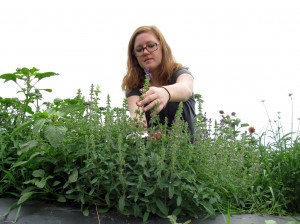To many people, flowers are fickle, useless, short lived and much too expensive. They view flower picking as a quick, thoughtless, mindless process. Arranging flowers is “easy” because “you just make it look pretty.” Yet, there’s so much more to flowers than meets the eye. Gomphrena, sunflowers, cornflower, strawflower, Scabiosa, snapdragons, and zinnias (including the Zowie hybrid, Senora and Exquisite cultivars) were some of the flowers in the cutting garden.
Flowers are usually picked in the morning. This is because the plant will not have a huge water deficit (as compared to afternoon or high sun) and are not wilting. As I went through the rows of flowers, I would remove any flowers that were dead, losing petals or in the seeding stage. By deadheading flowers, the plant will continue to send up blooms. Hence, one zinnia plant can be trained to flower all summer long.
Generally, I made a few yellow sunflower bouquets, a mixed sunflower bouquet, a pink or red zinnia bouquet, a snapdragon bouquet and a multicolored (yellow, green, red, orange, pink, yellow or mixed) zinnia bouquet. After that, I would mix together flowers to create different types of arrangements.
I made bouquets that used flowers with petal colors that would be opposite on the color wheel or having a contrasting scheme. For example, I would pair a yellow flower with a purple one, a white with a black or a red flower with a green one. This enhances each color. I would also do analogous scheme colored bouquets with nice cool blues and purples or pinks, reds and oranges. This creates a more uniform appearance, but allows each flower to be unique. The mixed color zinnia bouquet would be considered a polychromatic bouquet. Some bouquets were made to be viewed as a centerpiece while others were meant to be viewed facing a certain direction.
After cutting flowers and tying the bouquets, the flowers were placed in water and then re-cut. This keeps the arrangement lasting longer because the water will conduct up the stem. Had the flowers only been cut in air and not in water, the stem would have sucked up an air bubble, preventing the uptake of water. If water cannot be transported, the flower will begin dying sooner. The bouquets were then bagged, filled with water, tied and set in a half bushel basket for sale.
Many studies indicate the benefit of plants, nature and flowers. In particular, hospital patients with a view of trees, grass or flowers recovered faster than patients with views of concrete or brick walls. In World War II, there are letters in which soldiers asked family members to send a favorite flower or vegetable to grow in their fox holes. Secondly, flowers have dominated history. There’s the War of the Roses, the Tulip Craze, the poppies of In Flanders Fields, or the inclusion of flowers in art. Thirdly, flowers have been associated with health and death, sadness and happiness. Flowers are bursting in weddings, proms, homecomings and funerals. Many religious traditions include flowers. Flowers, although feeble, flimsy or whimsical have a place and purpose in history.
Even if one doesn’t care about flowers, they still can appreciate them. To eat that delicious orange, make that strawberry jam, or slice up that pepper, a flower needed fertilized. For that plant to flower, the leaves needed a signal from the day length. For those leaves to be present, a stem needed constructed. The stem couldn’t be constructed if it wasn’t anchored by roots. The roots would not occur if a small seedling didn’t germinate. Furthermore, that seedling came from a fertilized flower. The point merely is that to look at one specific area or aspect of the plant, the entire plant needs scrutinized and appreciated.





Speak Your Mind